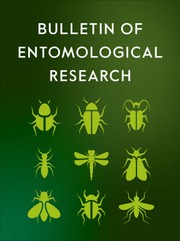No CrossRef data available.
Article contents
Formation of pupal rings in Ostrinia furnacalis: insights into environmental and physiological influences
Published online by Cambridge University Press: 19 June 2025
Abstract
Ostrinia furnacalis Guenée (Lepidoptera: Crambidae) is a key lepidopteran pest affecting maize production across Asia. While its general biology has been well studied, the phenomenon of pupal ring formation remains poorly understood. This study examined the factors influencing pupal ring formation under controlled laboratory conditions. Results showed that pupal rings were formed exclusively when larvae were reared on an artificial diet, with no ring formation observed on corn-stalks. Females exhibited a significantly higher tendency to participate in ring formation than males. Additionally, male participation increased proportionally with the number of rings formed, a pattern not observed in females. The size of the rearing arena significantly influenced ring formation, with smaller arenas (6 cm diameter) promoting more frequent pairing, particularly among females. Temperature also played a significant role: lower participation rates were recorded at 22 °C compared to 25 °C and 28 °C, although the number of rings formed did not differ significantly across temperatures. Developmental stage and sex composition further influenced pairing behaviour; pupal rings formed only among individuals of similar maturity, and male participation was significantly reduced in all-male groups compared to mixed-sex groups. These findings suggest that pupal ring formation in O. furnacalis is modulated by dietary substrate, larval sex, environmental conditions, and developmental synchrony, offering new insights into the behavioural ecology of this pest.
Keywords
Information
- Type
- Research Paper
- Information
- Copyright
- © The Author(s), 2025. Published by Cambridge University Press.
Footnotes
Authors contributed equally.


